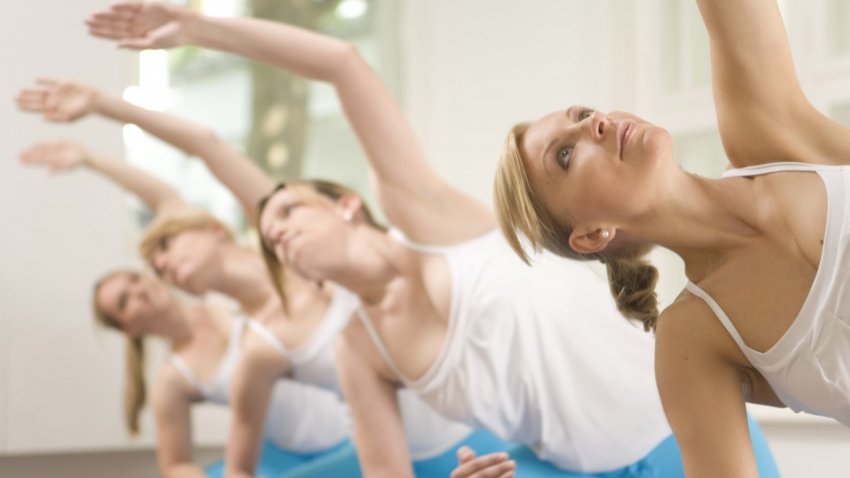View basket (0 items $0.00)

Study: Yoga Can Restore Balance for Stroke Survivors
What do downward-facing dog, tree pose, and child pose have to do with stroke survivors? According to a new study, these yoga postures, as well as other yoga movements can restore balance and significantly reduce the risk of falling for stroke patients with stroke-related movement impairment.
The study specifically looked at stroke survivors with hemiparesis, a weakness on one side of the body, which makes it difficult for stroke survivors to perform activities of daily living. About 80 percent of stroke survivors suffer from hemiparesis, making it one of the most significant health issues people experience after a stroke.
This study focused on stroke survivors, who had suffered strokes more than nine months earlier, and who were still recovering from hemiparesis. The participants practiced yoga for 1.5 hours, twice a week for two months in their homes with physical therapist certified as an integrated yoga instructor. At the end of the study, all participants showed improvements in both measures of balance and mobility.
The research from Massachusetts General Hospital and Harvard Medical School reinforces previous findings that stroke survivors who practice yoga can significantly cut their risk for falling and restore not only their balance, but their confidence to handle their daily activities. The purpose of the study was to assess the long-term impact of a yoga-based rehabilitation intervention in on balance, balance self-efficacy, fear of falling and quality of life after stroke in patients.
Though small in scope, (the research looked at four stroke survivors) the study is significant because it underscores these previous studies that have touted the long-term restorative power of yoga to restore balance and wellbeing after stroke, researchers said.
This is critical because balance tends to become a huge health issue as one gets older, but this is even more so the case for stroke surviviors. About 80 percent of people who have had a stroke have some degree of impaired balance, and they are more likely to hurt themselves if they fall: Studies show that strokes can quadruple the risk of breaking a hip after a fall. What’s more, 73 percent of elderly post-stroke patients fall within six months after being discharged from the hospital,
Additionally, more than 4.7 million people alive today have survived a stroke, making it the leading cause of adult disability in the United States. Many stroke survivors not only encounter long-term balance problems, which are associated with greater disability and an increased risk of falls. And, people who have had strokes also often experience loss of speech, weakness of limbs, diminished mental capacity and depression.
Yoga has been of particular interest to physical therapists searching for an effective yet gentle exercise balance in stroke survivors, as well as coordination of complex movements, strength, and breathing. Various case studies regarding recovery have indicated that survivors can handle both the physical and cognitive demands of yoga, and that it can be used as an effective rehabilitation exercise. Results from these studies include improvements in balance, strength, range of motion, and walking among the key factors which improve quality of life and reduce disability for survivors.
An earlier study published in the America Heart Association journal Stroke found that group yoga can improve balance in stroke survivors who no longer receive rehabilitative care. In that small pilot study in 2012, researchers tested the potential benefits of yoga among chronic stroke survivors — those whose stroke occurred more than six months earlier.
“For people with chronic stroke, something like yoga in a group environment is cost effective and appears to improve motor function and balance,” Arlene Schmid, Ph.D., O.T.R., lead researcher and a rehabilitation research scientist at Roudebush Veterans Administration-Medical Center and Indiana University, Department of Occupational Therapy in Indianapolis, Ind. said in a statement.
That study, published in the American Heart Association’s journal Stroke, involved 47 stroke survivors, mostly male veterans, who had had their stroke six months prior. The participants were still experiencing balance problems, which can be long-lasting after stroke, arising from injury to central brain structures and impaired senses. Difficulties with balance can lead to a higher risk of falls, further injury and continued disability.
Researchers also concluded that yoga may be more therapeutic than traditional exercise because the combination of postures, breathing and meditation may produce different effects than simple exercise, researchers said.
This mounting evidence suggests that it may also help stroke survivors reduce disability by boosting their coordination and strength. However, because of the small size of the studies, the researchers in both studies acknowledge that larger studies are needed to draw any firm conclusions.
Featured Courses








